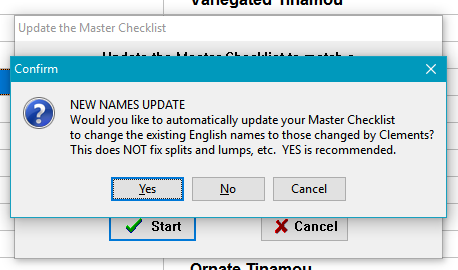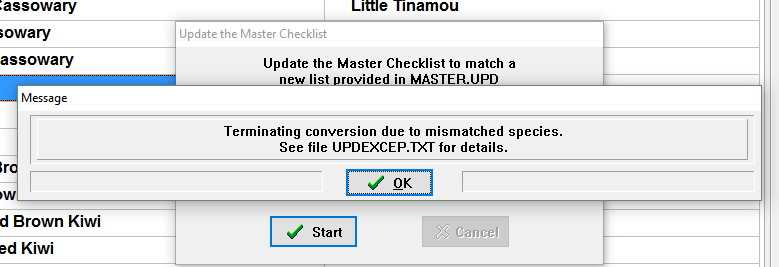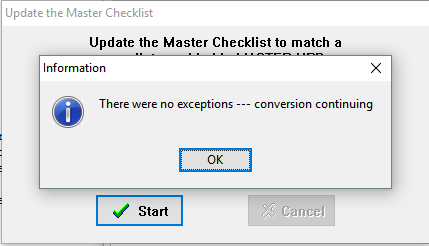Clements 2021 taxonomy update for AviSys
The 2022 taxonomy update can be anticipated around the end of October 2022.
To install the update, please follow this documentation very carefully. Read it through completely once before coming back to the beginning and actually performing the steps.
Note that you should be running AviSys Version 6.00M in order to perform the update. See how to check your AviSys version. I have no experience with what happens if you try the update on an older AviSys version. The update will deliver the 2021 taxonomy regardless of how long ago you last did a taxonomy update, it isn't necessary to run previous updates first. But naturally the longer it has been since you updated, the more conflicts you may have to resolve.
Backup!
Before you even think about installing the taxonomy update, you must know how to back up your current data set. And you must know how to restore from the backup. Run a backup immediately before beginning the update. The backup and restore procedure built-in to AviSys is simple and reliable. I use it all the time.
As far as I know, previous updates worked successfully for everyone who ran them. I've received no reports of serious problems; many people have commented on how well the update worked. I've also never heard of anyone actually having to recover by restoring a backup. Nevertheless, I do not warrant that the update will work for you. This is why it is so important for you to have a backup, and know how to restore it.
One approach that works well is to make a copy of your entire data folder under a new name just before performing the update. If you are dissatisfied with the results, you can just delete the updated folder and rename the copied folder back to the original name. If you are satisfied with the results, you can delete the copy of your old folder.
Not sure what I mean by data folder? Check this explanation.
If you have any custom checklists (ones that you marked yourself, manually), back them up. The update procedure does not update checklists, so after the update you will need to "Remove" all of your checklists and "Add" them back, in order to pick up any taxonomic changes. In the case of custom checklists, when you add them back, you will want to be able to mark them using your checklist backup file. If there are names in your backup file that have changed, you will get an exception file listing names that have to be corrected, similar to what you got for the main update. If you do not back up your custom checklists, they could be lost forever and you will have to recreate them from scratch. No backup procedure automatically backs up custom checklists in a way that will survive the update procedure, not the AviSys built-in backup procedure, nor any file backup technique. You must back them up one by one, using the method that is described here. Note that only custom checklists need to be backed up. You don't need to back up state or nation checklists because you'll just recreate them from the built-in data.
How many species?
This update is based on the 2021 Clements spreadsheet which has 10824 species. Of those, 160 are marked extinct (10664 not extinct), and like Jerry, with some exceptions I excluded all species that Clements designates as extinct. As in past updates, extinct species that are on the ABA checklist are included. These are the four extinct species in the ABA continental area (Labrador Duck, Great Auk, Passenger Pigeon, and Carolina Parakeet) plus 24 extinct Hawaiian species. Thus, this update has 10664+4+24 = 10692 world species. Note that there are other species on the ABA checklist such as Ivory-billed Woodpecker and Bachman's Warbler that may be extinct, but are not so designated by the Clements checklist.
The N.A. mode checklist has 1023 species. The N.A. mode checklist is constrained to continue to be a North American checklist; there is no way to integrate Hawaii into it. Thus, it can no longer match the ABA checklist, but does match the ABA checklist for the continental area. For guidance on how to display the new ABA checklist, see The new ABA checklist.
Built-in checklists
The taxonomic update also provides updates to the built-in state and province checklists. The built-in checklists are based on the most current records committee lists that I could find as of July 2021 (but do not include any species not accepted by ABA).
Also, the 2021 version of the nation checklist addon is available as a separate download.
Preparation for update
Some people are reporting that their antivirus program is interfering with the download. Referring to help files, or searching in Google, you should be able to find out how to disable your antivirus temporarily for the download. Here is information that I have found for a couple of troublesome programs:
First download and run the file AviSys Clements 2021 Taxonomy.exe.
Anti-virus warnings. It is likely that your anti-virus program will put up warnings when you try to run the program, for the simple reason that this is a program that the anti-virus program hasn't seen before, and is not in its database. Anti-virus programs are always suspicious about such programs and put up warnings even though they have no idea whether it's dangerous. You can run the program safely.
For example, on Windows 10 you might see this display.

When you run AviSys Clements 2021 Taxonomy.exe, it will deliver the files that you need. Then you will need to perform the steps below to apply the update.
Here is a list of all the files that are delivered in the update:
| AviSys main folder, e.g., C:\AVI6 | |
| SSDATA.AVI | The subspecies data |
| BANDCODE.AVI BANDSEL.AVI | Four-letter band codes for N.A. mode. |
| Alias.avi Alpha.avi Famfile.avi | Jump tables for N.A. mode |
| Walias.avi Wfam.avi Wfam2.avi | Jump tables for World mode |
| AviSys data folder, e.g., C:\AVI6\KENT | |
| MASTER.UPD | The taxonomy and state checklist update |
| NEWNAMES11.AVI | Provides simple 1-to-1 renames that don't involve splits or lumps |
| WLDCODE.AVI WORLDSEL.AVI |
Four-letter band codes for World mode. See Enhanced AviSys world bandcode files for more about these files. |
Installation steps
- Run AviSys, making sure that you are in the data set that you wish to update.
- If you are in N.A. Mode, switch to World Mode (by pressing the
S
key or clicking theSwitch
button). -
You should notice that in the Utilities menu, the choice “Update Master Checklist (from update file)” is clickable.
Click on it. If you do not have the file MASTER.UPD in your AviSys data folder for this data set,
then you did not run the update program successfully, and
this choice will be grayed-out (not clickable).

-
This is your last chance to stop and create a backup if you still haven't done it.
If you are ready, click Start.
(The “instructions that came in a file” are these instructions that you are reading now.)

- Beware that at this prompt, AviSys goes ahead with the update regardless of which button you click.
Be sure that you really meant it when you said you were ready to start at the previous prompt!
It's best to click “Yes” here.

-
Click Yes to this prompt.
It provides automatic name changes for one-to-one renames that don't involve splits or lumps.
Note: These renames are done on the first pass regardless of whether the entire update succeeds or not.
Thus, you will only see this prompt on the first try.
If you have to rerun the update, this prompt is not repeated after the first run.

-
Your first attempt to update may well abort due to exceptions that AviSys cannot resolve. This is not unusual. Click OK.

- Click yes, you do want to view the file.

- Here is what Jerry had to say about this:
YOUR INVOLVEMENT REQUIRED
It would have been nice to provide a taxonomy update that, with the push of a button, updates your entire master list and all sightings. Sadly, that CAN'T POSSIBLY happen. It would require AviSys to change your sighting records without your involvement --- that's simply too horribly dangerous. AviSys has no idea which species you actually saw; only you know that. So you will be involved with sighting records that need to be changed because of this update --- AviSys simply keeps you informed of what is going on in the process and makes it as easy as possible. HOWEVER, in this release, virtually all one-on-one English name changes are done automatically by AviSys, and you NEVER have to deal with Latin name changes in any case.
In short, if you have observations of a species whose name has disappeared from the taxonomy because of a split or lump, AviSys does not know what other species your observations of that species should be reassigned to. These are the cases that are listed as exceptions in the UPDEXCEP.TXT file, and you must resolve them manually before attempting the update again.
You will very likely have to do a little bit of research to learn how to resolve some taxonomic changes. You should be able to find everything you need in one of these sources:
Here are some details on how to performs splits and lumps:
Just in case you might have to start over on the update for some unexpected reason, keep a record of the changes that you make, so that it will be easier to repeat them.
Important! You must make changes to resolve exceptions before you can complete the update. But you also must check for certain other changes after you have completed the update. See the final step in these instructions.
-
After you have resolved all exceptions, restart at step 1, and try again. Or, if you were lucky and didn't have any exceptions on the first try, just keep going here.
-
If there are no exceptions, you will get this result. Click ok.

-
Beware that AviSys goes ahead and converts your data regardless of which button you click here. It's safest to click Yes.

-
When the update is completely applied, AviSys shuts down and you will need to restart it.

-
When you restart,
you will get two more prompts like this, for which there is nothing to do but click OK.
It doesn't actually take long on today's computers.


-
Restore your checklists. If you have any checklists defined, remove all of them and add them back. This is the only way for checklists to pick up taxonomic changes. For custom checklists, remove them and restore them from your backups. AviSys will provide you with an exception list if you need to adjust for any taxonomic changes. For built-in state checklists, just remove them and add them back using the built-in checklists. If you use the optional nation checklist addon, replace your RANGES.LST file with a fresh download from the nation checklist addon page.
If you find that your checklist sighting markers are not correct after restoring checklists, run “Set Checklist Markers” to fix them.

- Congratulations, you should be good to go! Verify that you have 10692 species in World Mode and 1023 species in N.A. Mode.
Final steps!
There may have been splits where the name of the original species was kept in the new taxonomy, so there was no exception even though the taxonomy is changed. These changes were not listed in the exception report; you must now manually look for them after you have successfully completed the update. For example, Sedge Wren was split into Sedge Wren and Grass Wren. Sedge Wren remains in the new taxonomy so there was no exception for it. You must now check your Sedge Wren records to see if any of them need to be moved to Grass Wren. You might have another armchair lifer! See the list of splits that you need to check. Also refer to the links that were listed above.